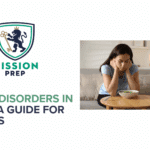Dissociative Identity Disorder signs in teenagers & When to Seek Help

Some days, your teen might feel like a complete stranger to you. It’s normal for teenagers to have mood swings, but your child’s moods seem to shift in the blink of an eye. Their behavior might seem completely out of character, and gaps in their memory may become a concern. If this is the case, you may be wondering, Is this just part of being a teenager…or something else?
What you’re noticing could be early signs of dissociative identity disorder (DID) in teens – a rare but very real (and treatable) mental health condition. Understanding the signs of DID is often the first step toward getting the right help for many people.
If you’re concerned about teenage dissociative identity disorder, professional mental health treatment is advised. DID can be highly distressing for a teen and their loved ones, and typically arises from trauma, so an informed approach may be necessary for their recovery.
This page can help you understand DID signs in teenagers and when to seek help, as it covers:
- What DID is in teens
- What causes dissociation in adolescents
- Common dissociative identity disorder signs in teenagers
- When to seek professional help
- Effective treatments for DID
- How to find professional support

What Is Dissociative Identity Disorder in Teens?
Dissociative identity disorder (DID) is a serious but rare mental health condition that is thought to affect up to two in every hundred people.1
To receive a diagnosis of DID means that a person experiences at least two separate personalities within themselves. Each of these personalities functions completely independently of the others: they may exhibit unique behaviors, voices, and memories. The separate identities are commonly known as “alters” – alternate identities.
DID can seem like a confusing concept; how can someone have different identities within themselves? Sometimes it can help to understand it by visualizing it.
Imagine a theatre with different actors waiting in the wings to take the stage. At any one time, an actor can step into the spotlight, meaning that the other actors fade into the background. With DID, different alters each take turns at being in the spotlight.
You may have heard people refer to DID as “multiple personality disorder” in the past, and some still refer to it in this way. However, this term stopped being used professionally in 1994, as it doesn’t accurately describe the mental health dissociation that teens with DID experience. The term “dissociative identity disorder” more accurately reflects the fact that, rather than there being many different personalities, there was originally a single identity that is now more fragmented.
Clearly, DID is a complex disorder, and being aware of the dissociative identity disorder symptoms adolescents may experience can help you to understand the condition better. However, before moving on to the symptoms of teenage DID, we will first explore the factors that can contribute to dissociation developing.
What Causes DID in Youth?
It’s not uncommon for parents to wonder why their child has developed DID. Often, DID has its roots in childhood trauma. In fact, it’s estimated that 90% of all people with DID have experienced early childhood trauma, such as neglect or abuse.2
For instance, if your child lived in a frightening home (as is the case with disorganized attachment) or lived in areas of war, they may be more at risk of developing DID.
Plus, compounding the trauma risk factor, studies show that severe forms of DID are frequently linked to early and chronic childhood abuse from either a parent or primary caregiver.3-5
Dissociation is the mind’s process for protecting you from trauma. It offers a way to detach yourself from whatever is happening. For a child stuck in a situation from which they can’t escape, dissociation becomes a necessary tool for survival. Yet it’s still a coping mechanism that they may have no control over. Further, if the child doesn’t get the opportunity to heal and process this early trauma, this coping mechanism may continue into adolescence and adulthood, developing into dissociative identity disorder.
It’s useful to note that dissociation can range in severity, from the mild end, such as daydreaming, to the more severe end – DID. Therefore, many people experience occasional dissociation. In fact, almost a third of people say that they sometimes feel like they are watching themselves in a movie.6 However, the severity and frequency of the dissociative episodes, along with the presence of “alters,” is what distinguishes DID from transient dissociation.
The next sections explore the most common dissociation symptoms youth experience living with DID.
Common Signs of Dissociative Identity Disorder in Teens
- The existence of at least two distinct identities
- Separate identities varying in relation to their behavior, memory, consciousness, and perception of the world
- Having discrete memory gaps or amnesia
- Symptoms causing problems with day-to-day life
It’s important to note that in a DID diagnosis, none of the above symptoms are linked to either substance use or cultural norms.
Below are some of the more common emotional, behavioral, and cognitive symptoms you may notice that might suggest your teen is struggling with DID.
Mood Swings DID Adolescents May Experience
It’s normal for teens to experience mood swings. However, if these mood shifts are very sudden, or don’t seem to be connected to the situation they are in, they may be experiencing the emotional instability DID adolescents face.
For example, you may notice your teen change from seeming confident to angry or withdrawn within the space of a few minutes. It might even seem as though you are talking to two different people. These emotional swings may also be accompanied by changes in posture or voice.3
Behavioral Changes and Self Identity Issues DID Youth Encounter
The behavioral changes DID teenagers experience can appear to be sudden, similar to the mood shifts. These shifts may occur from one day to the next, or even over the course of an hour. It can even feel as though your teen has become an entirely different person.
You may notice some of the following behavioral and identity changes in teens displaying different “alters”: 3,4
- Dressing in alternative ways to the usual
- Speaking in a different tone of voice
- Using different vernacular or vocabulary
- Having completely contrasting hobby or activity preferences
- Seeming to have different handwriting
- Changing mannerisms
- Alterations in gender expression
Amnesia Symptoms DID Teens Face
One key symptom of DID is amnesia that isn’t explained by typical forgetfulness. The unusual memory gaps teens experience with DID may include problems remembering parts of their day or conversations they have had.3
For example, they may have no recollection of how they got from one location to another, or they may find themselves wearing clothes they don’t remember putting on. They might also discover new belongings that they don’t remember buying, or notes written to themselves that they don’t recall writing. It’s possible there may even be times that they don’t immediately recognize family or close friends that they have known for years.
Confusion and Dissociation in Teens
Teens with DID may also struggle with feeling disconnected or confused as a result of dissociation.
For instance, there may be times when your teen is approached by someone they don’t know but who insists they have met them before. This person may even call them by another name. Other times, they might feel as though they are outside of their body, observing themselves doing something, as though watching themselves on a TV screen – completely disconnected. They may also feel as though things around them are not quite “real.” These could all be considered as teenage dissociation red flags.7
If some of these symptom examples seem familiar, this may be an indication that your teen is living with DID. Although the signs and symptoms can be distressing and confusing, both for the teen and family members, it’s important to remember that DID is a treatable medical condition. Getting the right help and support early can make a significant difference in your child’s life.
The primary treatment option for DID in teens is talking therapy, which will be discussed next.
How Therapy Can Help Teens With DID
Therapy is the primary treatment option for dissociative identity disorder in teens, and it may take a combined approach of different therapy styles to fully recover. This is because treating DID consists of three main stages:3
- Establishing safety, stabilization, and symptom reduction
- Confronting, working through, and integrating traumatic memories
- Reintegrating identities
These stages work by ensuring that the teen is in a safe state of mind before beginning to work through trauma that may have caused DID. This is because many patients with DID may experience suicidal ideation or self-harm, and their safety is of the utmost importance. Dialectical behavior therapy (DBT) can be a useful therapeutic approach in this stage as it allows teens to learn the skills necessary to manage distress and certain emotional symptoms.8
Once the teen is stable, they may then begin working through their trauma by accessing the traumatic memories through their “alters.” Trauma-focused therapies, such as trauma-focused cognitive behavioral therapy (TF-CBT) or eye movement desensitization and reprocessing (EMDR), can help address trauma-related symptoms and process past trauma and fragmented memories.9,10
The final phase of treatment focuses on reintegrating and bringing together the separate identities to become whole again. This is achieved by focusing on the teen’s relationship to their whole self – all of their parts – and to the rest of the world.
As you may be able to tell, recovery from DID isn’t usually a quick fix: it’s a process of self-exploration, working through trauma, and acceptance. But with the right professional support, your teen can heal and live a more fulfilling life.
When to Seek Professional Help
It’s normal for parents to wonder if their teenager’s mood swings and behaviors are a normal part of growing up or are a sign of something else at work. However, if your teen experiences repeated episodes of dissociation, feels confused often, or frequently finds gaps in their memories, the time may be right to consider seeking professional help.
To recap, the following are all common signs of DID young adults may experience:
- Episodes of “zoning out” or “spacing out”
- Memory loss
- Feeling disconnected from reality
- Distinct changes in personality or behavior
- Unexplained sudden mood shifts
- Difficulty functioning in daily life
- Feeling confused
If your teen experiences a couple of these symptoms, it may be time to reach out to a professional for an assessment of dissociative identity disorder in teens.

Find Support for Teens with DID at Mission Prep
If you’ve recognized some of the warning signs of DID in your teen, know that you don’t have to manage the next steps alone. With the right support and care, healing is completely possible. We are here to help.
At Mission Prep, we offer specialized treatment and care for teens living with DID, including:
- Assessments and diagnosis
- Individual, group, family, and trauma-informed therapy tailored to your teen’s needs
- Medication management, where appropriate
- A range of flexible care options, including:
- Outpatient therapy for ongoing support
- Residential care for teens needing more intense care
- Virtual sessions for teens who prefer therapy from the comfort of home
Whether you are concerned your teen may have DID, or they already have a diagnosis but need support going forward, our team is here to help every step of the way. Reach out to us today to find out how we can help your teen and family move toward a more connected future.
References
- DID-Research. (n.d.). Prevalence. Retrieved September 11, 2025, from https://did-research.org/did/basics/prevalence
- Şar, V. (2014). The Many Faces of Dissociation: Opportunities for Innovative research in Psychiatry. Clinical Psychopharmacology and Neuroscience, 12(3), 171–179. https://doi.org/10.9758/cpn.2014.12.3.171
- Mitra, P., & Jain, A. (2023, May 16). Dissociative Identity Disorder. StatPearls – NCBI Bookshelf. https://www.ncbi.nlm.nih.gov/books/NBK568768/
- Mayo Clinic. (n.d.). Dissociative disorders – Symptoms and causes. Retrieved September 16, 2025, from https://www.mayoclinic.org/diseases-conditions/dissociative-disorders/symptoms-causes/syc-20355215
- Sar, V., Dorahy, M., & Krüger, C. (2017). Revisiting the etiological aspects of dissociative identity disorder: a biopsychosocial perspective. Psychology Research and Behavior Management, Volume 10, 137–146. https://doi.org/10.2147/prbm.s113743
- Mental Health America. (2024, December 10). Dissociation and Dissociative Disorders. https://mhanational.org/conditions/dissociation-and-dissociative-disorders/
- Carlson, E.B. & Putnam, F.W. (1993). An update on the Dissociative Experience Scale. Dissociation, 6(1), p. 16-27. https://traumadissociation.com/des
- Foote, B., & Van Orden, K. (2016). Adapting Dialectical Behavior therapy for the treatment of dissociative identity Disorder. American Journal of Psychotherapy, 70(4), 343–364. https://doi.org/10.1176/appi.psychotherapy.2016.70.4.343
- Vancappel, A., Reveillere, C., El-Hage, W. (2022). Cognitive Behavior Therapy (CBT) for dissociative subtype PTSD: A case study. European Journal of Trauma & Dissociation, 6(4), 100290. https://doi.org/10.1016/j.ejtd.2022.100290
- Twombly, J. H. (2000). Incorporating EMDR and EMDR Adaptations into the Treatment of Clients with Dissociative Identity Disorder. Journal of Trauma & Dissociation, 1(2), 61–81. https://doi.org/10.1300/j229v01n02_05



















